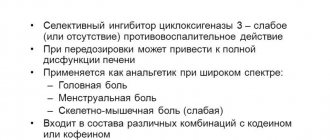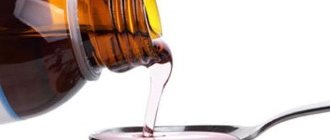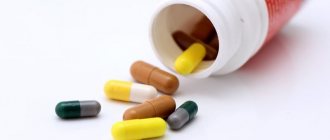Release form, packaging and composition of the drug Clinical-pharmacological group Pharmaco-therapeutic group Pharmacological action Indications for use Method of administration and doses Side effects Contraindications for use Use in children Special instructions Drug interactions
Registration Certificate Holder:
AGIO PHARMACEUTICALS, Ltd. (India)
ATX Code:
N02BE71
Active substance:
Dosage form:
Adzhikold
| The drug is approved for use as an over-the-counter product | Adzhikold | Tablets reg. No.: LP-001522 dated 02/16/12 - Valid |
Release form, packaging and composition of the drug Adzhicold
Pills
from orange to light orange with orange inclusions, round, flat, with a dividing line on one side.
| 1 tab. | |
| paracetamol | 500 mg |
| phenylephrine hydrochloride | 10 mg |
| chlorphenamine maleate | 2 mg |
| caffeine | 30 mg |
Excipients
: sodium carboxymethyl starch 10 mg, povidone 5 mg, propylene glycol 2 mg, corn starch 32 mg, methyl parahydroxybenzoate 1 mg, propyl parahydroxybenzoate 0.1 mg, sunset yellow dye 0.9 mg, talc 1 mg, microcrystalline cellulose 5 mg, magnesium stearate 5 mg, water up to 604 mg.
4 things. - PVC/aluminum foil blisters (1) - cardboard envelopes. 4 things. - blisters made of PVC/aluminum foil (1) - cardboard packs. 4 things. - PVC/aluminum foil blisters (1) - cardboard envelopes (25) - cardboard packs.
Adjicold tab No. 10
Compound
Active ingredients:
- paracetamol - 500 mg;
- phenylephrine hydrochloride - 10 mg;
- chlorphenamine maleate - 2 mg;
- caffeine - 30 mg.
Excipients: sodium carboxymethyl starch 10 mg, povidone 5 mg, propylene glycol 2 mg, corn starch 32 mg, methyl parahydroxybenzoate 1 mg, propyl parahydroxybenzoate 0.1 mg, sunset yellow dye 0.9 mg, talc 1 mg, microcrystalline cellulose 5 mg, magnesium stearate 5 mg, water up to 604 mg.
Pharmacokinetics
Data on the pharmacokinetics of the drug Adjicold are not provided.
Indications for use
Symptomatic treatment of colds, acute respiratory viral infections, including influenza (fever, pain, rhinorrhea).
Contraindications
Severe atherosclerosis of the coronary arteries;
arterial hypertension; portal hypertension; diabetes; simultaneous use of tricyclic antidepressants, monoamine oxidase inhibitors (MAO), beta-blockers; hypersensitivity to paracetamol and other components included in the drug; taking other drugs containing substances included in the drug AjiCold®; pregnancy, breastfeeding period; children under 15 years of age; alcoholism. Carefully:
For hyperthyroidism, pheochromocytoma; bronchial asthma; chronic obstructive pulmonary disease; emphysema; chronic bronchitis; deficiency of glucose-6-phosphate dehydrogenase; hemolytic anemia; blood diseases; acute hepatitis; congenital hyperbilirubinemia (Gilbert, Dubin-Johnson and Rotor syndromes); liver and/or kidney failure; simultaneous use of drugs that can adversely affect the liver (barbiturates, phenytoin, phenobarbital, carbamazepine, rifampicin, isoniazid, zidovudine and other inducers of microsomal liver enzymes); pyloroduodenal obstruction; stenosing ulcer of the stomach and/or duodenum; closed-angle form of glaucoma; epilepsy; prostatic hyperplasia; and also by persons with a deficit of caloric intake from food, AjiCold® can be used with caution after consultation with a doctor.
Directions for use and doses
Inside.
Adults and children over 15 years old - 1 tablet 3-4 times a day. The maximum daily dose is 4 tablets.
The course of treatment is no more than 5 days.
Storage conditions
Store out of the reach of children, at a temperature not exceeding 25°C.
Best before date
3 years. Do not use after the expiration date stated on the package.
special instructions
During the treatment period, you should refrain from taking alcohol, sleeping pills and anxiolytic (tranquilizers) medications.
Do not take with other medicines containing paracetamol.
If symptoms worsen or persist after 5 days of using the drug, you should stop taking it and consult your doctor.
The drug may cause drowsiness.
If the medicine has become unusable or has expired, do not throw it into wastewater or onto the street! Place it in a bag and place it in the trash. These measures will help protect the environment!
Description
A drug for the symptomatic treatment of acute respiratory diseases.
Dosage form
Tablets from orange to light orange in color with orange inclusions, round, flat, with a score line on one side.
Use in children
Contraindicated for children under 15 years of age.
Pharmacodynamics
Combined drug.
Paracetamol
has an antipyretic and analgesic effect: reduces the pain syndrome observed during colds - sore throat, headache, muscle and joint pain, reduces high temperature.
Phenylephrine
has a vasoconstrictor effect - reduces swelling and hyperemia of the mucous membranes of the upper respiratory tract and paranasal sinuses.
Chlorphenamine
has an antiallergic effect: eliminates itching of the eyes, nose and throat, swelling and hyperemia of the mucous membranes of the nasal cavity, nasopharynx and paranasal sinuses, reduces exudative manifestations.
Caffeine
has a stimulating effect on the central nervous system (CNS), which leads to a decrease in fatigue and drowsiness, and an increase in mental and physical performance.
Side effects
From the immune system: skin rash, itching, urticaria, angioedema, anaphylactic shock.
From the blood and lymphatic system: anemia, thrombocytopenia, agranulocytosis, hemolytic anemia, aplastic anemia, methemoglobinemia, pancytopenia, leukopenia.
From the nervous system: headache, dizziness, drowsiness, difficulty falling asleep, increased excitability.
From the organ of vision: mydriasis, paresis of accommodation, increased intraocular pressure.
From the heart: tachycardia, palpitations.
From the side of blood vessels: increased blood pressure.
From the respiratory system, chest and mediastinal organs: bronchospasm.
From the gastrointestinal tract: nausea, vomiting, epigastric pain, diarrhea, dry oral mucosa, hepatotoxic effect.
From the skin and subcutaneous tissues: very rarely - serious skin reactions:
- acute generalized exanthematous pustulosis (AGEP). Acute condition with the development of pustular rashes. It is characterized by fever and diffuse erythema, accompanied by burning and itching. Swelling of the face, hands and mucous membranes may occur;
- Stevens-Johnson syndrome (SJS) (erythema malignant exudative). A severe form of erythema multiforme, in which blisters appear on the mucous membrane of the mouth, throat, eyes, genitals, and other areas of the skin and mucous membranes;
- toxic epidermal necrolysis (TEN, Lyell's syndrome). The syndrome is a consequence of extensive apoptosis of keratinocytes, which leads to detachment of large areas of skin at the dermoepidermal junction. The affected skin looks like it has been scalded by boiling water.
From the kidneys and urinary tract: nephrotoxicity (renal colic, glycosuria, interstitial nephritis, papillary necrosis), difficulty urinating.
If you notice one of the side effects described above, you should stop taking the drug and consult a doctor immediately.
Use during pregnancy and breastfeeding
Due to the lack of clinical data, the safety of the drug during pregnancy and breastfeeding has not been established, therefore the use of the drug in this category of patients is contraindicated.
Interaction
- Enhances the effects of MAO inhibitors, sedatives, ethanol.
- Antidepressants, antiparkinsonian drugs, antipsychotic drugs, phenothiazine derivatives increase the risk of developing urinary retention, dry mouth, and constipation.
- Glucocorticosteroids increase the risk of developing glaucoma.
- Microsomal oxidation inhibitors (cimetidine) reduce the risk of hepatotoxicity.
- Metoclopramide and domperidone increase, and cholestyramine reduces the rate of absorption of paracetamol.
- Paracetamol reduces the effectiveness of uricosuric drugs.
- When used simultaneously with barbiturates, diphenin, carbamazepine, rifampicin, isoniazid, zidovudine and other inducers of microsomal liver enzymes, the risk of developing the hepatotoxic effect of paracetamol increases.
- When chloramphenicol and paracetamol are used together, the half-life of chloramphenicol may be increased.
- In most patients taking warfarin long-term, infrequent use of paracetamol usually has little or no effect on the international normalized ratio (INR).
- However, with prolonged regular use, paracetamol enhances the effect of indirect anticoagulants (warfarin and other coumarin derivatives), which increases the risk of bleeding.
- A single dose of caffeine increases lithium excretion by the kidneys. Abrupt cessation of caffeine may result in increased serum lithium concentrations.
- Chlorphenamine simultaneously with MAO inhibitors and furazolidone can lead to hypertensive crisis, agitation, and hyperpyrexia.
- Concomitant use of phenylephrine with digoxin and other cardiac glycosides may increase the risk of arrhythmia and myocardial infarction.
- Phenylephrine when taken with MAO inhibitors can lead to increased blood pressure.
- Phenylephrine reduces the effectiveness of beta-blockers and antihypertensive drugs.
- Tricyclic antidepressants enhance the adrenomimetic effect of phenylephrine; simultaneous use of halothane increases the risk of developing ventricular arrhythmia.
- Reduces the hypotensive effect of guanethidine, which, in turn, enhances the alpha-adrenomimetic activity of phenylephrine.
Overdose
In case of overdose, consult a doctor immediately. Prompt medical attention is critical, even if you do not experience any signs or symptoms.
- Caffeine
Symptoms of acute overdose: abdominal pain, vomiting, flushing of the face, fever, chills, agitation, insomnia, irritability, loss of appetite, weakness, tremor, increased muscle tone, state of altered consciousness, delirium, hallucinations, increased blood pressure followed by its decrease, tachycardia, tachypnea, increased diuresis, hypokalemia, hyponatremia, hyperglycemia, metabolic acidosis, convulsions, myoclonus and rhabdomyolysis, supraventricular and ventricular arrhythmias.
Symptoms of chronic caffeine intoxication - “caffeineism”: irritability, insomnia, anxiety, emotional lability, chronic abdominal pain.
- Chlorphenamine
Symptoms: central nervous system depression, hyperthermia, anticholinergic syndrome (mydriasis, flushing, fever, dry mouth, urinary retention, intestinal paresis), tachycardia, decreased blood pressure, increased blood pressure, nausea, vomiting, agitation, disorientation, hallucinations, psychosis, seizures, arrhythmias.
Rarely, patients with agitation, seizures, or comatose patients develop rhabdomyolysis and renal failure.
- Phenylephrine
Symptoms: nausea, vomiting, irritability, agitation, insomnia, psychosis, convulsions, palpitations, tachycardia, increased blood pressure, reflex bradycardia.
- Paracetamol
Symptoms appear after taking more than 7.5-10 g: during the first 24 hours after taking - pallor of the skin;
nausea, vomiting, anorexia, abdominal pain; increase in prothrombin time; impaired glucose metabolism, metabolic acidosis (including lactic acidosis). Symptoms of liver dysfunction may appear 12-48 hours after an overdose: increased activity of “liver” transaminases, hepatonecrosis. In severe cases - liver failure with progressive encephalopathy, coma. Rarely, liver failure develops rapidly and can be complicated by renal failure (tubular necrosis).
The overdose threshold may be lowered in elderly patients and children; in patients taking certain medications (eg, liver microsomal enzyme inducers), alcohol, or who are malnourished.
Treatment: gastric lavage, administration of activated carbon in the first 6 hours after an overdose, administration of SH-group donors and precursors for the synthesis of glutathione - methionine 8-9 hours after an overdose and acetylcysteine after 12 hours. The need for additional therapeutic measures (further administration of methionine and acetylcysteine) is determined by the concentration of paracetamol in the blood, as well as the time elapsed after its administration.
Symptomatic therapy.
Impact on the ability to drive vehicles and operate machinery
The drug may cause drowsiness. During the treatment period, it is necessary to refrain from driving vehicles and machinery and engaging in other potentially hazardous activities that require increased concentration and speed of psychomotor reactions.
pharmachologic effect
Combined drug. Paracetamol is an analgesic-antipyretic. It has an antipyretic and analgesic effect, chlorpheniramine has an antiallergic and anti-edematous effect. Reduces vascular permeability, eliminates swelling and hyperemia of the nasal mucosa, suppresses the symptoms of allergic rhinitis, making breathing easier. Phenylephrine has a vasoconstrictor effect, thereby helping to relieve nasal congestion and reduce nasal discharge. Caffeine has a stimulating effect on the central nervous system, which leads to a decrease in fatigue and drowsiness, and an increase in mental and physical performance.
Contraindications for use
- hypersensitivity to the components of the drug;
- simultaneous use of other drugs containing substances included in Adjicold;
- simultaneous use of tricyclic antidepressants, MAO inhibitors, beta-blockers;
- pregnancy, lactation period;
- children's age (up to 6 years).
Carefully:
with deficiency of glucose-6-phosphate dehydrogenase; blood diseases, liver and/or kidney failure, angle-closure glaucoma, benign prostatic hyperplasia; Gilbert's syndrome, arterial hypertension, thyroid diseases, diabetes mellitus, bronchial asthma.
Similar drugs:
- Carsil Dragee
- Ascorutin Oral tablets
- Yogurt Capsule
- Ergoferon () Lozenges
- Magne B6 Oral tablets
- Omez Capsule
- Papaverine Oral tablets
** The Drug Directory is intended for informational purposes only. For more complete information, please refer to the manufacturer's instructions. Do not self-medicate; Before starting to use the drug AjiCOLD, you should consult a doctor. EUROLAB is not responsible for the consequences caused by the use of information posted on the portal. Any information on the site does not replace medical advice and cannot serve as a guarantee of the positive effect of the drug.
Are you interested in the drug AjiCOLD? Do you want to know more detailed information or do you need a doctor's examination? Or do you need an inspection? You can make an appointment with a doctor - the Euro lab is always at your service! The best doctors will examine you, advise you, provide the necessary assistance and make a diagnosis. You can also call a doctor at home . Euro lab clinic is open for you around the clock.
** Attention! The information presented in this medication guide is intended for medical professionals and should not be used as a basis for self-medication. The description of the drug AjiKOLD is provided for informational purposes only and is not intended for prescribing treatment without the participation of a doctor. Patients need to consult a specialist!
If you are interested in any other drugs and medications, their descriptions and instructions for use, information about the composition and form of release, indications for use and side effects, methods of use, prices and reviews of drugs, or you have any other questions and suggestions - write to us, we will definitely try to help you.
Drug interactions
Enhances the effects of MAO inhibitors, sedatives, ethanol. Antidepressants, antiparkinsonian drugs, antipsychotics, phenothiazine derivatives increase the risk of developing urinary retention, dry mouth, and constipation. Glucocorticosteroids increase the risk of developing glaucoma. Paracetamol reduces the effectiveness of diuretics. Chlorpheniramine combined with MAO inhibitors and furazolidone can lead to hypertensive crisis, agitation, and hyperpyrexia. Tricyclic antidepressants enhance their sympathomimetic effect; simultaneous administration of halothane increases the risk of developing ventricular arrhythmia. Reduces the hypotensive effect of guanethidine, which, in turn, enhances the alpha-adrenergic stimulating activity of phenylephrine.





